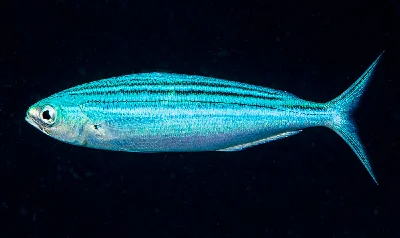Striped Fusilier
Caesio striata
The Striped Fusilier (Caesio striata) is a tropical, marine species commonly associated with coral reefs. It is a non-migratory fish, found at depths ranging from 2 to 30 meters. The maximum recorded length for this species is 25 cm, with an average length of 24 cm.
The Striped Fusilier is characterized by its anatomical features, including 10 dorsal spines, 14-16 dorsal soft rays, 3 anal spines, and 12 anal soft rays. Its body exhibits a light bluish to greenish coloration dorsally and transitions to white ventrally. It has 3-4 scales on its cheek, 19-25 predorsal scales, and both its dorsal and anal fins are scaled. The supra-temporal band of scales is continuous at the dorsal midline. Typically, the upper peduncular scale rows number 11 (occasionally 11-12), while the lower peduncular scale rows usually range from 14-15. The species possesses a small process on its basioccipital bone for the attachment of Baudelot's ligament, a single post-maxillary process, and a maxilla with a blunt posterior end.
Caesio striata primarily inhabits coastal areas near coral reefs, where it forms midwater aggregations and sustains itself on a diet of zooplankton. It reproduces oviparously, releasing numerous small pelagic eggs.
The genus name, Caesio, derives from the Latin term "caesius," meaning bluish-grey, and was established in 1835. It is the same term used to describe the element Caesium (Cs), a silvery metal.
This species is distributed throughout the undefined, from the 🌊 Red Sea to the Arabian Sea.
Comments
Please, sign in to leave comment
No Comments yet
Last Update: May 28, 2025

